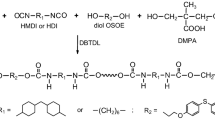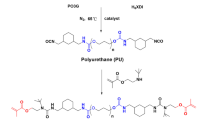Abstract
A new approach to the preparation of hydrophobic porous polymers has been proposed. Three series of porous polymers which pores equally well-absorbed as water and organic liquids (benzene and iso-octane) were synthesized by visible light polymerization from compositions based on three different dimethacrylic esters with n-butanol. Three block copolymers based on N-vinylpyrrolidone and 2,2,3,3-tetrafluoropropyl methacrylate, differing in the length of the poly-(2,2,3,3-tetrafluoropropyl methacrylate) block, were synthesized for the purpose of hydrophobization of such porous polymers. A distinctive feature of synthesized block copolymers is that they are soluble only in methanol. It has been found that the treatment of porous polymers only with 2 wt.% of block copolymer methanol solution leads to a decrease water uptake by an order of magnitude, and the absorption of organic liquids does not change. In the course of the study it was possible to obtain a hydrophobic porous polymer sample that has water contact angle θ = 121° and a low value of the polar component of the surface Gibbs energy (\( {\gamma}_s^p=0.2 \) mJ·m−2). The fundamental possibility of using such material for purification of organic liquids from water is shown.

ᅟ











Similar content being viewed by others
References
Wu D, Xu F, Sun B, Fu R, He H, Matyjaszewski K (2012) Design and preparation of porous polymers. Chem Rev 112(7):3959–4015. https://doi.org/10.1021/cr200440z
Svec F (2004) Preparation and HPLC applications of rigid macroporous organic polymer monoliths. J Sep Sci 27(10–11):747–766. https://doi.org/10.1002/jssc.200401721
Vlakh EG, Maksimova EF, Tennikova TB (2013) Monolithic polymeric sorbents for high-performance chromatography of synthetic polymers. Polym Sci Ser B 55(1):55–62. https://doi.org/10.1134/s1560090413020061
Peroni D, Vanhoutte D, Vilaplana F, Schoenmakers P, de Koning S, Janssen HG (2012) Hydrophobic polymer monoliths as novel phase separators: application in continuous liquid–liquid extraction systems. Anal Chim Acta 720:63–70
Jose AJ, Ogawa S, Bradley M (2005) Tuning the pore size and surface area of monodisperse poly(methyl acrylate) beads via parallel seeded polymerisation. Polymer 46(9):2880–2888. https://doi.org/10.1016/j.polymer.2005.02.001
Arriaga EA (2004) Monolithic Materials: Preparation, Properties and Applications. Journal of Chromatography Library, Volume 67 Edited by František Švec (University of California, Berkeley), Tatiana B. Tennikova (Russian Academy of Sciences, St. Petersburg), and Zdeněk Deyl (Academy of Sciences of the Czech Republic, Prague). Elsevier: Amsterdam. 2003. xx + 780 pp. $350.00. ISBN 0-444-50879-1. J Am Chem Soc 126(31):9874–9874. https://doi.org/10.1021/ja0335925
Baten’kin MA, Konev AN, Mensov SN, Chesnokov SA (2011) Formation of heterogeneous polymer structures during photoinduced crosslinking of oligo(ester acrylates) in the presence of a nonpolymerizable component. Polym Sci Ser A 53(7):558–568. https://doi.org/10.1134/s0965545x11070029
Baten’kin MA, Konev AN, Mensov SN, Chesnokov SA (2012) Self-formation of nanoporous polymeric materialsin photopolymerizable composition with nonpolymerizable components. Opt Mem Neural Network 21(1):27–33. https://doi.org/10.3103/s1060992x12010067
Baten’kin MA, Mensov SN (2012) A diffusion model of the development of concentration heterogeneities in a photopolymerizable environment with allowance for the limited compatibility of a monomer and a polymer. Polym Sci Ser B 54(9):496–503. https://doi.org/10.1134/s1560090412100016
Baten’kin MA, Mensov SN (2015) Optical formation of polymeric materials with heterogeneously distributed nanopores from a photopolymerizable composite. J Polym Res 22(4):64. https://doi.org/10.1007/s10965-015-0702-x
Baten’kin MA, Mensov SN, Morozova MA, Polushtaytsev YV (2015) Neutral component localization in the volume of photopolymerizable medium by the counter moving boundaries of initiating radiation action. J Polym Res 22(12):247. https://doi.org/10.1007/s10965-015-0886-0
Baten’kin MA, Mensov SN (2016) Optical control of microphase separation of the photopolymerized composition based on oligo(ester acrylates) for the preparation of polymer materials with the nonuniform nanopore distribution. Russ Chem Bull 65(1):259–267. https://doi.org/10.1007/s11172-016-1294-2
Baten’kin MA, Polushtaytsev YV, Khamaletdinova NM, Chechet YV, Chesnokov SA, Mensov SN (2017) Experimental determination of microphase separation conversion during photopolymerization of cross-linking monomers to control the evolution of optical inhomogeneities in the volume of the forming polymer. J Polym Res 24(11):185. https://doi.org/10.1007/s10965-017-1350-0
Levkin PA, Svec F, Fréchet JMJ (2009) Porous polymer coatings: a versatile approach to Superhydrophobic surfaces. Adv Funct Mater 19(12):1993–1998. https://doi.org/10.1002/adfm.200801916
Erbil HY, Demirel AL, Avci Y, Mert O (2003) Transformation of a simple plastic into a Superhydrophobic surface. Science 299(5611):1377–1380
Hou X, Wang X, Zhu Q, Bao J, Mao C, Jiang L, Shen J (2010) Preparation of polypropylene superhydrophobic surface and its blood compatibility. Colloid Surface B 80(2):247–250. https://doi.org/10.1016/j.colsurfb.2010.06.013
Ahmad AL, Mohammed HN, Ooi BS, Leo CP (2013) Preparation and characterization of a porous superhydrophobic polymeric surface via facile technique. J Polym Res 20(12):289. https://doi.org/10.1007/s10965-013-0289-z
Jiang B, Zhang L, Shi J, Zhou S, Liao B, Liu H, Zhen J, Pang H (2013) Synthesis, characterization and bulk properties of well-defined poly(hexafluorobutyl methacrylate)-block-poly(glycidyl methacrylate) via consecutive ATRP. J Fluor Chem 153:74–81
Krafft MP (2012) Controlling phospholipid self-assembly and film properties using highly fluorinated components – fluorinated monolayers, vesicles, emulsions and microbubbles. Biochimie 94(1):11–25. https://doi.org/10.1016/j.biochi.2011.07.027
Amado E, Kressler J (2011) Triphilic block copolymers with perfluorocarbon moieties in aqueous systems and their biochemical perspectives. Soft Matter 7(16):7144–7149. https://doi.org/10.1039/C1SM05339F
Scheirs J (ed) (1997) Modern fluoropolymers. Wiley, New York
Berlin AA, Kefeli TY, Korolev GV (1967) Poly(ester acrylates). Nauka, Moscow
Gordon AJ, Ford RA (1973) The Chemist's companion. Wiley, New York
Chesnokov SA, Cherkasov VK, Abakumov GA, Mamysheva ON, Chechet YV, Nevodchikov VI (2001) Influence of o-benzoquinone nature on initiation of radical polymerization by the o-benzoquinone - Tert-amine system. Russ Chem Bull 50(12):2366–2371. https://doi.org/10.1023/a:1015079328446
Zamyshlyayeva OG, Deniskina IV, Filippov AP, Semchikov YD (2011) Synthesis and self-organization of amphiphilic poly(N-vinylpyrrolidone-2,2,3,3-tetrafluoropropyl methacrylate) diblock copolymers in solution and bulk. Polym Sci Ser A 53(8):691–697. https://doi.org/10.1134/s0965545x11080128
Gregg SJ, Sing KSW (1982) Adsorption, surface area, and porosity. Academic Press, London
Ruckenstein E, Lee SH (1987) Estimation of the equilibrium surface free energy components of restructuring solid surfaces. J Colloid Interface Sci 120(1):153–161. https://doi.org/10.1016/0021-9797(87)90334-1
Kaelble DH (1971) Physical chemistry of adhesion. Wiley-Interscience, New York
Feng L, Zhang Z, Mai Z, Ma Y, Liu B, Jiang L, Zhu D (2004) A super-hydrophobic and super-Oleophilic coating mesh film for the separation of oil and water. Angew Chem Int Ed 43(15):2012–2014. https://doi.org/10.1002/anie.200353381
Acknowledgements
The study was financially supported by the Russian scientific foundation (project No. 17-73-10452).
Author information
Authors and Affiliations
Corresponding author
Rights and permissions
About this article
Cite this article
Kovylin, R.S., Baten’kin, M.A., Kulikova, T.I. et al. Amphiphilic fluorinated block-copolymer coating for the preparation of hydrophobic porous materials. J Polym Res 25, 208 (2018). https://doi.org/10.1007/s10965-018-1602-7
Received:
Accepted:
Published:
DOI: https://doi.org/10.1007/s10965-018-1602-7




